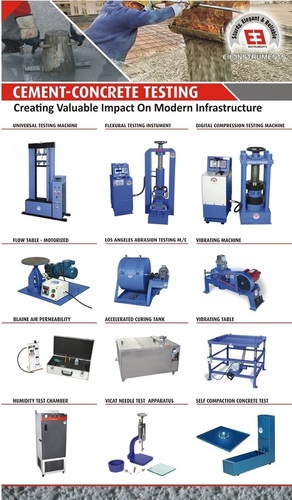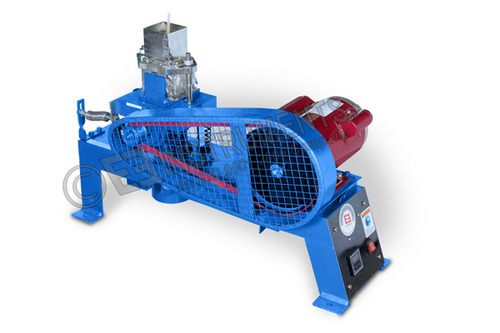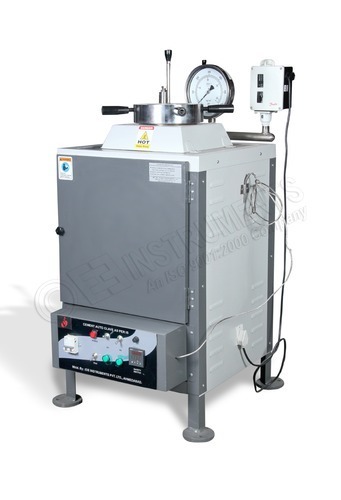Cement Testing Equipments
Price 1.00 INR/ Piece
Cement Testing Equipments Specification
- Resolution
- 0.1 N
- Frequency
- 50 Hz
- Automation Grade
- Semi-Automatic/Automatic
- Mounting Type
- Bench-top
- Application
- Strength, consistency, fineness, setting time, and soundness testing
- Hardness
- HRC 55-60 (steel components)
- Equipment Type
- Cement Testing Equipments
- Response Time
- <2 seconds
- Gas Pressure
- 0.5-1.5 MPa (if applicable)
- Accuracy
- 1%
- Max Height
- Up to 250 mm (for some models)
- Color
- Multi
- Humidity
- Relative humidity 50% 5%
- Usage
- Industrial
- Temperature
- 10C to 35C
- Interface Type
- RS232 / USB (optional)
- Specimen Size
- 40 x 40 x 160 mm (standard cube/mortar bar)
- Port Size
- Standard 1/4 inch NPT
- Product Type
- Cement Testing Equipments
- Features
- Corrosion resistant, heavy-duty, precise measurements
- Power Supply
- 220-240V AC, 50 Hz
- Measuring Range
- Adjustable, depends on accessory
- Test Range
- Up to 1000 N
- Display Type
- Digital / Analog
- Operating Voltage
- 220 V
- Number of Specimens
- Single/Multiple (based on attachment)
- Capacity
- Up to 100 kN
- Machine Weight
- Approx. 50-80 kg (varies by model)
- Test Speed
- 12 mm/min
- Test Width
- 32 mm (for standard specimens)
- Test Stroke
- Up to 60 mm
- Control Mode
- Manual/Automatic
Cement Testing Equipments Trade Information
- Minimum Order Quantity
- 1 Piece
- FOB Port
- Ahmedabad
- Payment Terms
- Telegraphic Transfer (T/T), Cash Against Delivery (CAD), Letter of Credit (L/C), Cash in Advance (CID), Cheque, Cash Advance (CA)
- Supply Ability
- 150 Pieces Per Year
- Delivery Time
- 4 Week
- Sample Policy
- Contact us for information regarding our sample policy
- Packaging Details
- Wooden packing with strong base
- Main Export Market(s)
- Australia, Africa, Middle East, South America, Asia
- Main Domestic Market
- All India
- Certifications
- ISO 9001 : 2015
About Cement Testing Equipments
We are here to offer our clients an efficiently working array of Cement Testing Equipments. These are used at construction sites for measuring the workability of the cement and ensure its proper utilization. The equipments are made using best quality stainless steel which give them resistance to impact and corrosion. These include flow table, vibrating table, self-compaction concrete test and many others to name. The Cement Testing Equipments are energy efficient as well as environment friendly. These are easier to operate as well as handle and do not require much involvement of labor. The equipments have longer working life and are dependable.
Features of Cement Testing Equipments:
- Used at construction sites for testing the workability of the cement.
- Can be accessed in customers in different types to meet their requirements.
- Accurate as well as defect free surface finish.
- High tensile strength and have the ability to bear heavy weight without damage.
Advanced Safety for Reliable Operation
Safety is embedded in every aspect of our cement testing equipment, featuring overload protection and emergency stop switches to safeguard both operators and machinery. The control panel is user-friendly, minimizing operational errors. These mechanisms ensure continuous, trouble-free operation for rigorous industrial applications.
Comprehensive Testing and Compliance
Our machines are meticulously engineered to meet IS:4031, ASTM C109, and EN 196 standards, supporting strength, consistency, fineness, setting time, and soundness tests. Supplied with calibration certificates, they guarantee international compliance and result accuracy for quality assurance in all test environments.
Versatile Functionality and Accessories
Each system is delivered with essential accessories including tamping rods, measuring beakers, cube moulds, and vibration machine attachments. With adjustable measuring ranges and support for both manual and automatic control modes, these machines provide broad testing flexibility for single or multiple specimens.
FAQs of Cement Testing Equipments:
Q: How does the overload protection feature in cement testing equipment enhance safety during operation?
A: The overload protection automatically halts the machine if excessive force is detected, preventing potential damage to both the equipment and the specimen. This helps ensure operator safety and prolongs the lifespan of the machine.Q: What calibration process is followed for the supplied cement testing equipment?
A: Each unit is delivered with a calibration certificate, ensuring that measurements meet accuracy standards. Calibration follows the protocols specified in IS:4031, ASTM C109, and EN 196, and is performed before dispatch for immediate usage.Q: When should the emergency stop switch be used on cement testing equipment?
A: The emergency stop switch should be activated in situations where rapid equipment shutdown is necessary, such as unexpected operational issues or safety concerns, to immediately stop all test functions and prevent accidents.Q: Where can the cement testing equipment be installed for optimal performance?
A: These machines are designed for bench-top mounting in industrial laboratory settings with controlled temperature (10C to 35C) and relative humidity (50% 5%) to maintain accuracy and prevent corrosion.Q: What is the process for testing cement strength using this equipment?
A: Typical strength tests involve preparing specimens using supplied cube moulds and accessories, applying controlled loads via manual or automatic modes (up to 100 kN capacity), and monitoring results on digital or analog displays with fast response times and high resolution.Q: How are results displayed and stored on the cement testing equipment?
A: Results are shown on either digital or analog displays, with optional RS232 or USB interfaces enabling data export and analysis for efficient record-keeping and quality control.Q: What are the key benefits of using these cement testing machines in industrial environments?
A: Users benefit from precise measurements, robust construction, corrosion resistance, compliance with major standards, intuitive controls, flexible automation, and comprehensive accessory supportmaking them reliable, efficient solutions for cement quality assessment.

Price:
- 50
- 100
- 200
- 250
- 500
- 1000+
More Products in Cement Testing Equipment Category
DETERMINATION OF RESISTANCE TO ABRASION
Price 1.00 INR / Piece
Minimum Order Quantity : 1 Piece
Application : Industrial
Product Type : DETERMINATION OF RESISTANCE TO ABRASION AS PER IS 171902020
Usage : laboratory
Machine Weight : 40 Kg
Vibrating Machine With Digital Timer and Mould
Price 1.00 INR / Piece
Minimum Order Quantity : 1 Piece
Application : A specially designed vibration machine is used for vibrating the mix in moulds at a frequency of 12000 400 cycles per minute, as per specifications.
Product Type : Vibrating Machine
Usage : Industrial
Machine Weight : 76 Kilograms (kg)
Cement Autoclave
Price 1.00 INR / Piece
Minimum Order Quantity : 1 , , Piece
Application : The Autoclave is suitable for conducting accelerated soundness test on cements by the autoclave expansion test requiring constant steam pressure with the correspondent constant temperature.
Product Type : Cement Autoclave
Usage : For Cement Testing Equipment
Machine Weight : 98 Kilograms (kg)
Photometric Test Apparatus
Price 1.00 INR / Piece
Minimum Order Quantity : 1 Piece
Application : For Quick Determination Of SO3 In Cement
Product Type : Cement Testing Equipment
 |
EIE INSTRUMENTS PVT. LTD.
All Rights Reserved.(Terms of Use) Developed and Managed by Infocom Network Private Limited. |

 Send Inquiry
Send Inquiry




